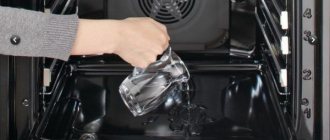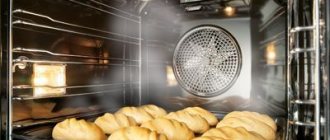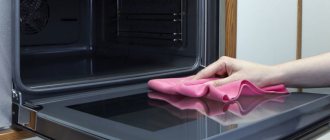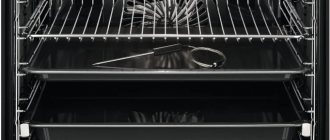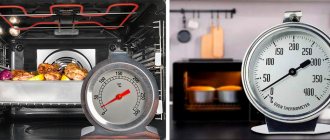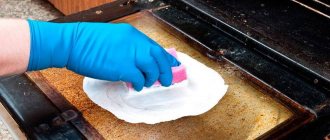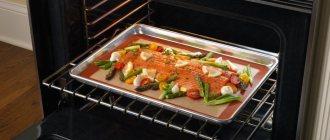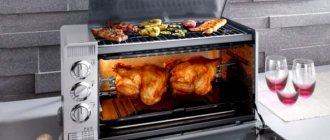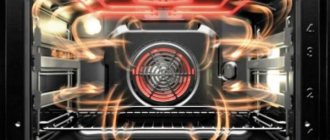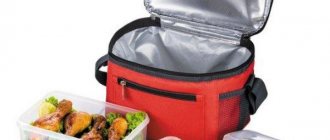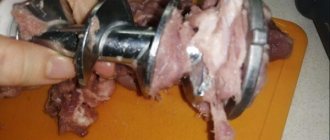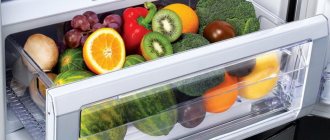The oven is an extremely difficult device to keep clean. After each cooking, all surfaces become covered with a layer of fat and burnt food particles. The inner walls and door are thoroughly washed, but after the next use of the oven everything happens again. At the same time, few people succeed in cleaning it completely; there are many places in the oven that are difficult to reach.
Manufacturers of kitchen appliances are well aware of this problem and are taking action. Today there are several options for removing contaminants, differing in specificity and quality. One of the most effective options is catalytic purification, which should be discussed separately.
Why do you need to clean your oven?
After cooking, plaque, streaks and layers of fat and small food particles remain on the inner walls of the oven. If they are not cleaned immediately, the fat layer will polymerize. After some time, the deposits turn into a rubber-like film, which does not dissolve with conventional detergents and can only be cleaned mechanically.
When the oven operates at high temperatures, these layers begin to burn. This causes the food to acquire an unpleasant odor, and the appearance of the oven becomes unattractive and sloppy. The problem intensifies when, after meat or fish dishes, they begin to prepare baked goods, which become saturated with foreign odors and lose their quality.
Most users don't go deep into cleaning methods, using conventional washing techniques using a damp cloth and standard detergents. However, their effectiveness in this case is extremely low. Layers of fat, particles of burnt food and other elements that have undergone heat treatment do not respond to conventional formulations.
Attempts to remove plaque mechanically often give the opposite result - the coating ends up scratched and damaged. In addition, the situation is aggravated by the time factor - if it is still possible to clean the fat immediately after the oven has cooled, then after a few hours this procedure will be much more difficult.
Expert opinion
Borodina Galina Valerievna
Every housewife is jealous of the appearance and condition of kitchen equipment, so the problem of removing deposits becomes common and very relevant.
Hydrolysis oven cleaning
Another convenient way to clean your oven from grease is hydrolysis cleaning. It is carried out using water and consists of the following:
- Water and cleaning agent are poured into the container.
- The container is placed in the oven for 20-30 minutes at a temperature not exceeding 90 degrees.
- Under the influence of steam, the fat is cleaned, and after the process is completed, all that remains is to wipe it off with a rag.
It is important to understand that hydrolysis is not so much a self-cleaning method, but rather a convenient and quick way to deal with contaminants. It can only be used if the fat has not had time to dry.
Advantages of the method:
- Low cost.
- Low energy consumption.
Flaws:
- Not a self-cleaning method.
- The method is effective only in cases where the dirt is fresh.
- Do not use immediately after you have finished cooking. This is because the oven will be too hot to use this method.
Even experts do not always know which cleaning method is right for your oven. But there are several inventions that will help make your work easier:
- Possibility to install a removable door on the oven.
- Installation of a special design that pushes the entire working part of the oven out and allows you to completely remove it.
What methods are there?
It is not always possible to immediately clean up traces of food preparation. Cleaning often has to be delayed, which increases the complexity of the procedure. Manufacturers of kitchen appliances are trying to solve this issue by using different types of coatings and special types of enamel. These methods are usually called self-cleaning methods, which is quite close to the truth, although there are many nuances.
Today there are three types of self-cleaning ovens:
It can only be classified as “self-cleaning” with some stretch. Its essence is to place a baking sheet or a special form with water at the bottom of the oven. The oven is turned on, the water heats up and turns into steam. The layers on the inner walls soften, after which they can be quite easily cleaned off the walls. You still have to remove the plaque manually, so the method is considered the most unattractive. However, ovens of this type are inexpensive, which significantly increases their chances in stores.
Hydrolysis method- The pyrolysis cleaning method involves heating the oven strongly and creating a high temperature inside it. All leftover food simply burns, turning into ash. The user will only need to remove it from the inside when the oven has cooled down. There are multi-level pyrolysis cleaning methods that use different heating modes. Each type of product burns under certain conditions, so some manufacturers equip their products with advanced systems that prevent the device from heating up again. Cleaning is very tough, requiring great endurance and strength from surfaces. These ovens are among the most expensive models.
- Catalytic cleaning has a milder regime than pyrolysis. In addition, with this method, the user is not required to carry out a separate procedure, since cleaning is carried out while the oven is operating. A special enamel is applied to the walls, the pores of which contain a catalyst. When heated, all layers interact with it and turn into carbon and water. The heating mode is much softer, only 140°-200° versus almost 500° with the pyrolysis method. These properties make catalytic descaling technology the most preferred over all alternatives. In addition, the average cost of ovens of this type is approximately in the middle between pyrolysis and hydrolysis models, which significantly influences the choice of buyers.
Each of these methods is effective only under certain conditions.
Features of catalytic cleaning
Catalytic purification is a milder version of the pyrolytic method. The main difference is the removal of fatty deposits during oven operation. This saves time and does not require a special procedure. However, over time, the catalyst loses its performance, which forces users to renew the coating.
As a rule, special material is applied only to the inner walls of the oven, excluding the bottom and glass door. These areas are equipped with removable panels coated with enamel with catalytic properties. The glass door and bottom of the cabinet are cleaned using the traditional method. This is inconvenient, but there is no other way to solve the problem.
The specificity of catalytic cleaning is such that enamel can be used in any type of oven - both electric and gas. The service life of the enamel is approximately 300 hours, after which the effect decreases. In such situations, the panels are replaced, and if double-sided planes were initially installed, they are simply turned over to the other side.
Ovens with catalytic surface cleaning are labeled EcoClean. This is a trade designation for the technique. When choosing the right model, you need to take into account the terminology used to avoid confusion. For example, hydrolysis cleaning systems are labeled EasyClean, which looks similar and may cause an error. It is recommended to consult with the seller to clarify how to clean the product.
What does catalytic oven cleaning mean?
Catalytic cleaning is a method of removing contaminants from the internal surfaces of the oven . Based on the effect of catalysis - the breakdown of contaminants under the influence of high temperature and catalysts.
Reference. "Catalysis" means "destruction" in Greek.
The principle of operation is the effect of high temperature on the catalyst - a chemical substance in the inner coating of the oven chamber, which, when reacting with fat, reduces its combustion temperature several times.
As a result of the oxidative reaction, fat is rapidly destroyed and decomposed into water and soot. All dirt gradually burns out and at the end of cleaning, ashes remain in the oven, which can be easily removed by hand.
Oven steam cleaning function
All about pyrolytic cleaning of ovens
What is hydrolysis oven cleaning
Basic operating principles
Ovens with a built-in catalytic function do not require additional preparation for cleaning . The entire process occurs without launching a special mode.
The operating principle boils down to the following points:
- automatic activation of the function during cooking;
- when a certain temperature is reached (+140-250°C), a chemical oxidation reaction starts. As a result, grease and other contaminants deposited on the walls disintegrate, turning into water and soot (carbon);
- After the procedure is completed and the device has cooled, the user can only clean the surfaces of the chamber with a soft, damp sponge.
It is worth noting that the catalytic type of oven cleaning is an absolutely safe invention for human health , but at the same time effective.
Features of ovens with this system
Ovens with a catalytic cleaning system have some distinctive features:
- The top, side and back panels of the inner chamber are covered with a special fat-absorbing enamel with pores. The enamel pores are filled with a catalyst (manganese, cobalt, copper or cerium oxide), as well as an absorbent with nanoparticles.
- Grease absorbing filter. It is not present in all models, but many manufacturers recommend purchasing it additionally. This will extend the life of the device.
- The bottom and inside of the oven door are not enamel, so cleaning them will require additional effort and time.
- The grease-absorbing coating wears off during use and requires replacement.
The function is present in electric and gas models of ovens , in contrast to the pyrolytic cleaning system, which is equipped exclusively with electric appliances.
Catalytic filters and panels
Catalysis in the oven occurs due to the internal walls with a special coating and catalytic grease filters.
Internal walls are also called removable panels . They differ in service life and concentration of the catalytic substance in the enamel. The panels also come with single-sided and double-sided coating. Such characteristics depend on the model of the household device and the manufacturer.
Reference. The average service life of catalytic panels is 4-5 years.
At the end of their service life, the panels require replacement , since the special coating wears off:
- one-sided panels are replaced with new ones - they either do it themselves, following the instructions, or contact the service center specialists;
- Double-sided panels are simply turned and installed the other way. This increases the service life of some components to 8-10 years.
Catalytic grease filters reduce the grease layer on the chamber walls . They have special containers that collect contaminants. The devices require periodic cleaning, which can also be done in the dishwasher.
Reference. If there is a filter in the oven, the frequency of cleaning is reduced by 2-3 times.
Difference from steam (hydrolysis)
The difference between steam and catalytic types of cleaning is very significant. It concerns almost all aspects of the technique.
What is the cleaning method for your oven?
HydrolyticCatalytic
Let's look at the differences between these methods:
for steam cleaning, a special procedure must be carried out, while catalytic cleaning occurs during cooking;- steam treatment softens deposits, and catalytic treatment decomposes fat into water and carbon;
- The composition of the layers for steam cleaning is not significant. With the catalytic method, only fat and its derivatives are processed. Melted sugar and milk can destroy catalytic enamel;
- the temperature created during hydrolysis purification is in the range of 50°-90°. For the catalytic method, a more severe regime is needed - from 140° to 200° (sometimes raised to 250°).
Steam cleaning occurs in a softer, more gentle mode. It takes about half an hour to heat up, plus the time required to remove the softened deposits by hand. The catalytic method does not require manual cleaning, although in practice it is still necessary to remove the remains of decomposed deposits or residues of other products that are not fat or its derivatives.
Advantages and disadvantages
This method is suitable for housewives who do not have enough time to wash the oven by hand, but cannot imagine the cooking process without this device. Advantages of the method:
- Plates with this function are not that expensive. Catalytic cleaning is not a serious and expensive technology.
- Significant time savings, since the process occurs during cooking, so the oven always remains clean.
- It is not difficult to remove the results of catalytic cleaning; you just need to wipe the special plate of the device.
- The service life of the grease-absorbing coating is about five years, after which it can be replaced. Many models are equipped with a plate with double-sided coating. This allows you to simply turn it over and forget about cleaning the oven for another 5 years. You can do this yourself by simply following the instructions.
- Both gas and electric stoves have this function, so you can choose the one that suits your taste.
- If the catalytic plates are installed on an electric stove, then this cleaning method saves energy.
- It is equally effective in any model and any brand.
- Increasing effect with repeated use.
Oven with plates for catalytic cleaning
Unfortunately, not everything is so perfect, and the catalytic system has its drawbacks:
- The catalytic coating (plate) cannot clean large amounts of accumulated grease. This leads to the need to run the oven empty or use other available methods for cleaning the contaminated surface.
- The door and bottom of the oven remain unprotected: they will have to be washed manually.
- You also have to wash the grate and other cooking utensils yourself.
- One of the least effective methods.
- Does not tolerate sweets or dairy products. Those places on the plate where prohibited substances have entered immediately lose their fat-absorbing function.
Do not wash catalytic plates with a hard sponge or use products containing abrasive elements.
Advantages and disadvantages of this method
The advantages include:
- the procedure occurs automatically, simultaneously with cooking, which saves time and saves the owner from unnecessary effort;
- catalytic enamel is universal and can be used in both electric and gas appliances;
- the quality of cleaning depends little on the manufacturer or model. Only the shape and configuration of the surfaces have some influence;
- There are ovens with catalytic cleaning from different manufacturers on sale;
- the cost of such models is noticeably lower than that of ovens with pyrolytic cleaning.
Flaws:
- Cleaning is designed only for fat deposits. The technique has relatively low efficiency when working with drops of sugar or dairy products;
- removable elements, baking trays, cabinet doors in any case have to be cleaned in the traditional way;
- Regular cleaning is required. This means that you will only have to cook at high temperatures (about 200°);
- After the service life of the catalytic enamel has expired, the plates will have to be replaced.
As a rule, replacement is carried out every 4-5 years. This is not a very expensive procedure (it costs 2-4 thousand rubles without the cost of the plates themselves), but for the user this necessity constitutes a certain burden.
Advantages of the method
Since catalytic purification is a simple chemical reaction, it does not require complex technologies or expensive components. Therefore, such a system stands out among developments at an affordable price. In addition, it has a number of other advantages:
- significantly saves time spent on stove maintenance;
- the oven does not need to be washed after each cooking;
- cleaning occurs while cooking, so it does not require additionally turning on the oven and wasting electricity or gas;
- The warranty period for the enamel is about 5 years.
We recommend: How to properly clean your laptop screen?
Over time, the protective coating wears off and must be replaced with a new one. In some models of equipment, the walls are treated with catalytic enamel on both sides. In this case, they need to be turned over to the new side. You can easily carry out the manipulation yourself, as the instructions describe the procedure in detail. But if a person is not able to cope with the work, the service center employees will quickly reinstall the walls.
When using catalytic cleaning, you do not need to select a special place in the kitchen to install the oven. The system works without interruption everywhere and does not heat the stove to such an extent as to damage furniture or other household appliances in the immediate vicinity.
Rating of models with this function
Convenience and a favorable combination of price and capabilities have caused high demand for ovens with catalytic cleaning. Therefore, all leading manufacturers have several models of this type in their assortment.
Beko BIM 22304 XCS
The chamber volume is 71 l, 8 heating modes are available, recessed switches prevent accidental changing of the operating mode. Cost 30,000 rubles.
Bosch HBJ558YS0Q
Oven with independent installation type, 8 heating modes, chamber volume 66 l, maximum heating 275°. Cost 31,000 rubles.
Electrolux OPEA 4300 X
Independent type cabinet, compact size with a 55 l chamber, 7 heating modes, maximum temperature 250°. Cost 18,000 rubles.
Gorenje BO758A31WG
The case is white, there is an external timer, all types of heating, a door with triple glass. Cost 50,000 rubles.
Hansa BOEI69422
The oven has 10 heating modes, the maximum temperature is 250°. Cost 25,000 rubles.
Korting OKB 792 CFW
Chamber 65 l, 9 heating modes available, tact rotary switches. Cost 37,500 rubles.
Fornelli FEA 45 Sonata
Compact cabinet with a chamber volume of 45 l. There are 9 heating modes, convection, 1 year warranty. Cost 40,000 rubles.
Expert opinion
Borodina Galina Valerievna
Analyzing the properties of these models, one can note a noticeable difference in their cost. It is determined by the range of functions and other design features of the ovens. The type of cleaning in this case is not the determining factor.
How to choose the right one
Catalytic cleaning is considered one of the simplest, so it is customary to select such models based on other criteria - the set of functions, maximum heating temperature, chamber volume, etc.
However, some useful tips from experts will help you avoid mistakes and choose the most successful option:
catalytic cleaning is suitable for users who plan to frequently cook at high temperatures. To prepare delicate dishes at a relatively low temperature, it is better to choose hydrolytic models;- catalytic panels can be installed only on the back wall, or on the entire internal surface of the cabinet (except for the door and bottom). It is recommended to choose the most secure models;
- It must be remembered that milk or sugar streaks not only remain on the surface, but also damage the panel. Therefore, for baked goods and other dessert-type products, it is better to purchase models with a different type of cleaning;
- There are different brands of catalytic enamel. It is recommended to choose an oven with an EcoClean system, which is highly durable and can restore its performance to some extent.
It will be useful to get advice from the seller and carefully study the instructions for the oven. This will not take too much time, but will give the most reliable answers to all questions that arise.
Conclusion
Catalytic cleaning of the oven occurs automatically, with virtually no human intervention. This is its noticeable advantage, since the user does not need to undertake a special event to remove burnt deposits. However, you should not count on perfect surface cleanliness, since not all products have the same properties. Care and periodic maintenance of the oven are necessary in any case, so you should not neglect the basic rules for operating kitchen appliances.
